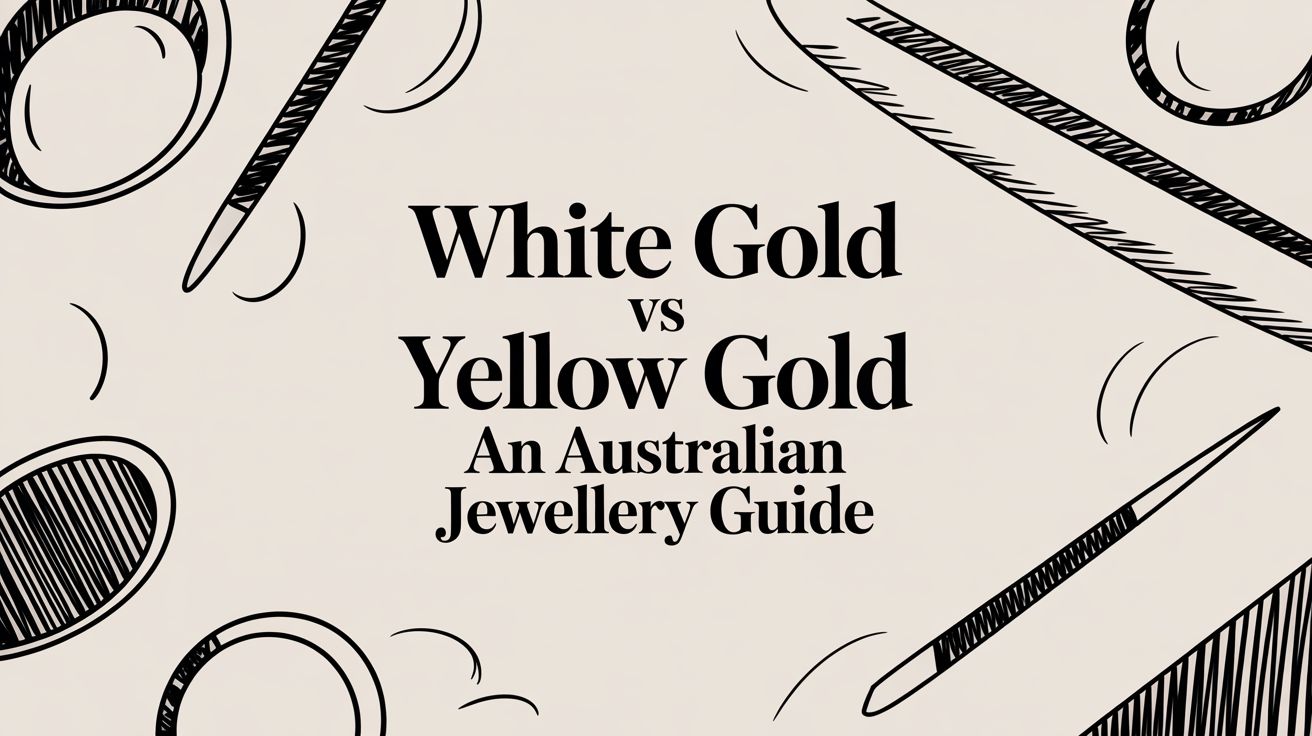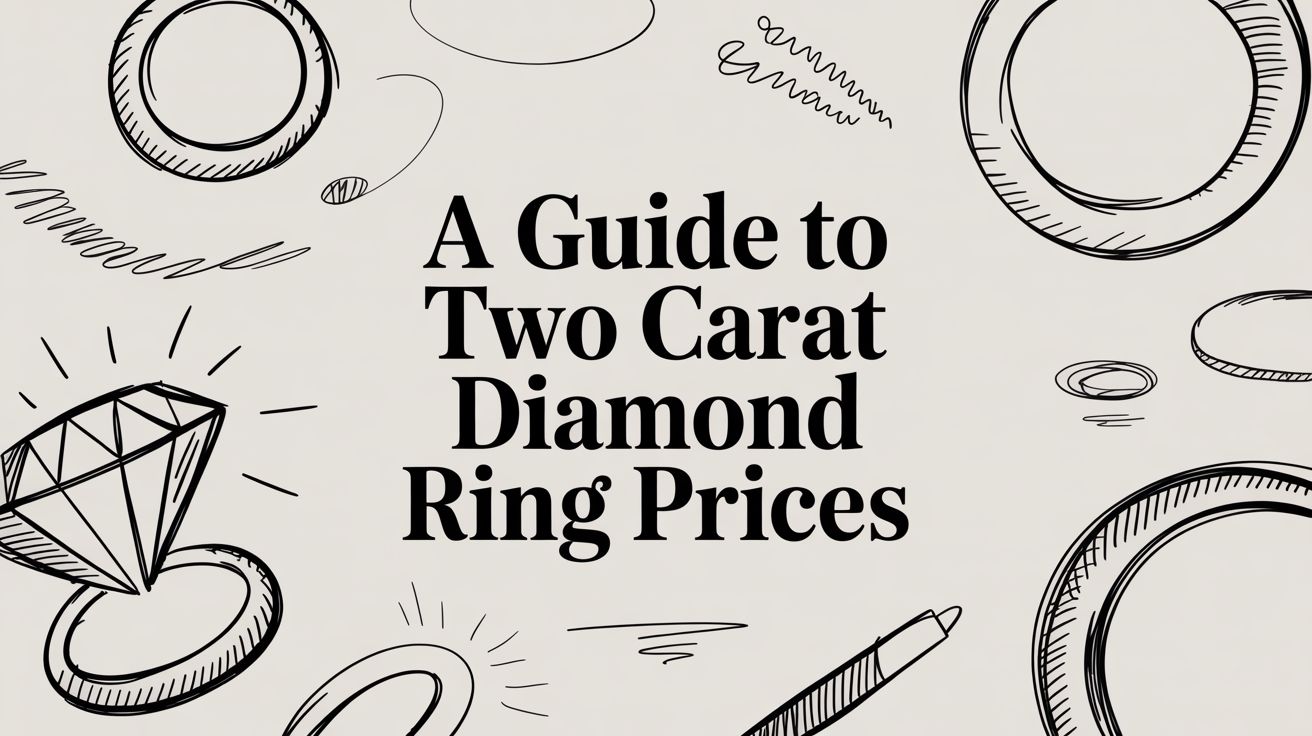When you’re choosing the perfect metal for a special piece of jewellery, the age-old debate of white gold vs yellow gold often comes first. It really boils down to this: white gold gives you a crisp, modern, silvery finish that makes colourless diamonds pop, whereas yellow gold offers that classic, warm glow that feels truly timeless. The right choice for you will hinge on your personal style, your lifestyle, and how much upkeep you're prepared for.
A Clear Comparison: White Gold vs Yellow Gold
Picking between these two beautiful metals can seem daunting at first, but it gets much easier once you understand their key differences. Both are gorgeous options, no doubt, but the way they're made, how they look, and the care they need are suited to different people and priorities.
White gold gets its cool, silvery lustre from being mixed with white metal alloys like palladium and then coated in a layer of brilliant rhodium. On the other hand, yellow gold keeps its natural, warm colour because it's alloyed with metals like copper and zinc. This isn't just about looks; it impacts everything from how well the ring wears over time to its long-term maintenance.
At a Glance: White Gold vs Yellow Gold
To help you see the differences side-by-side, here’s a quick breakdown of what sets these two metals apart.
| Attribute | White Gold | Yellow Gold |
|---|---|---|
| Appearance | Bright, silvery-white, modern | Warm, rich yellow, classic |
| Durability | Slightly harder, more scratch-resistant | More malleable, prone to dents |
| Maintenance | Requires rhodium re-plating every 1-2 years | Needs occasional polishing to restore shine |
| Best For | Colourless diamonds, cool skin tones | Warmer-toned gems, olive or dark skin |
| Hypoallergenic | Depends on alloy (nickel can be an irritant) | Generally hypoallergenic (nickel-free) |
This table gives a solid overview, but let's dive into what these points mean for you in the real world.
If you’re a visual person, this simple decision tree can help you see which path aligns best with your tastes.
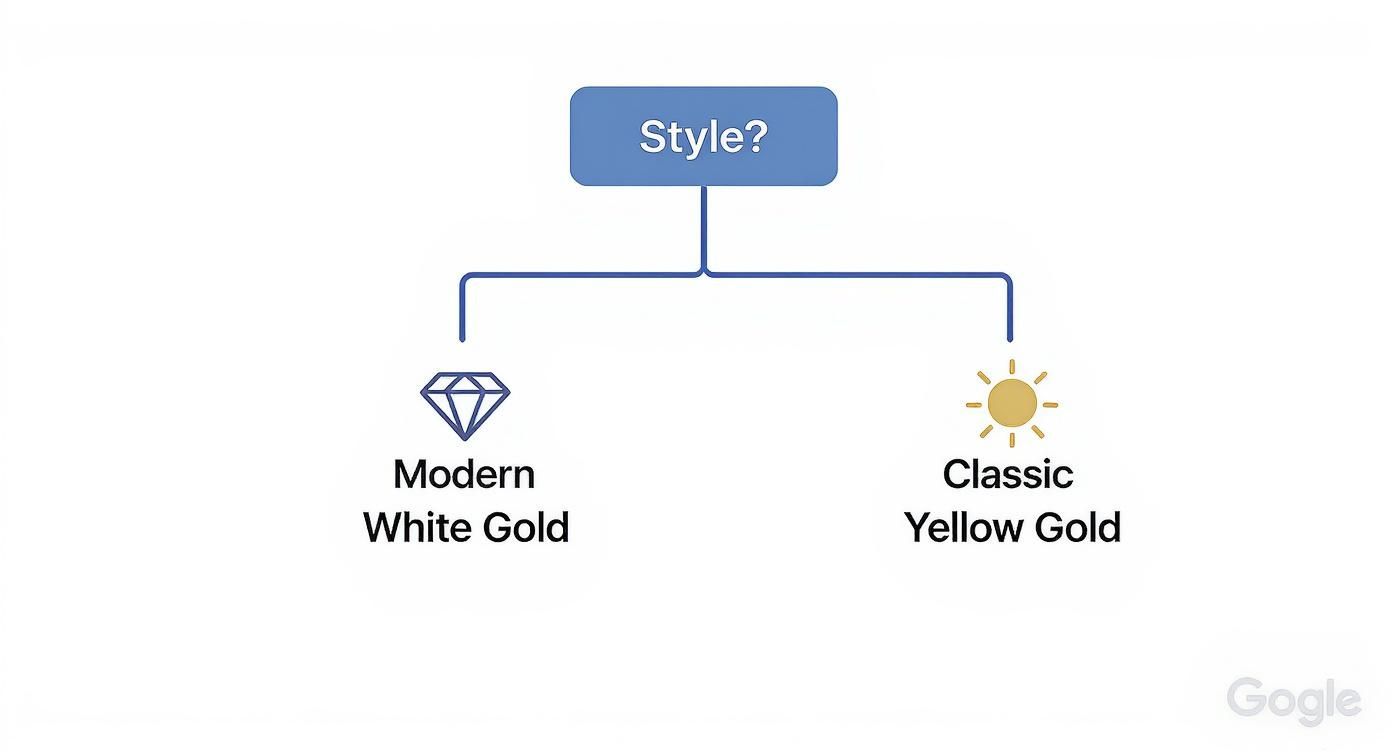
As the infographic shows, the journey often starts with a simple style question: are you drawn to modern or classic aesthetics? Think of this as your starting point. Now, we'll get into the finer details of each metal to help you make a choice you’ll be happy with for years to come.
What’s Actually In Your Gold? Composition and Colour
To really get to the bottom of the white gold vs. yellow gold question, you need to look at what they’re made of. Pure, 24-karat gold is stunning, but it's far too soft for something you’d wear every day. To give it the strength it needs, jewellers mix pure gold with other metals, creating what’s called an alloy.
It’s this specific blend of metals that creates the distinct look and properties of both white and yellow gold. They're both gold at their core, but their recipes are completely different.
The Classic Warmth of Yellow Gold
Yellow gold is all about celebrating the natural, rich colour of pure gold. The goal of its alloy is to enhance strength while keeping that beautiful warm hue. It's typically mixed with metals like copper and zinc.
- Copper lends a subtle rosy warmth to the final colour and makes the metal much tougher.
- Zinc helps to lighten the tone slightly and makes the alloy easier for jewellers to work with.
The result is that timeless, classic glow we all know. Because this colour comes from the metal mix itself, it’s permanent. It won't fade or change over time—all it needs is a good polish now and then to keep it shining.
Yellow gold’s beauty lies in its authenticity. That warm colour is baked into its very structure, not just a coating, which is why it has been a symbol of luxury for millennia.
The Bright, Cool Shine of White Gold
White gold, on the other hand, is specifically engineered for a modern, silvery-white look that rivals platinum. This is done by alloying pure gold with white metals, most commonly palladium and silver. Some older alloys used nickel, but this is less common today due to potential skin sensitivities.
Even with these white metals, the alloy still has a faint, warmish-yellow tint. So, to get that brilliant, mirror-like shine, every piece of white gold jewellery is plated with a super-thin layer of rhodium. Rhodium is a precious metal from the platinum family, and it’s responsible for that stunning lustre while also providing a hard, protective barrier against scratches. This plating process is a fundamental difference between the two metals.
Karats: The Universal Measure of Purity
Whether it’s white or yellow, the purity of the gold is measured in “karats” (k). This tells you how many parts out of 24 are pure gold.
- 18k Gold: This is 75% pure gold (18 parts) mixed with 25% other metals. It has a deep, rich colour and is considered the standard for fine, high-end jewellery.
- 14k Gold: This option contains 58.3% pure gold (14 parts) and 41.7% other metals. The higher percentage of alloys makes it more durable and scratch-resistant, which is a great, practical choice for pieces you'll wear daily.
It's important to remember that an 18k white gold ring has the exact same amount of pure gold as an 18k yellow gold ring. The only difference is in that other 25% of alloy metals. Knowing this makes it clear that the choice between them comes down to colour and maintenance, not the intrinsic value of the gold itself.
Australia's role as a major gold producer offers a fascinating local perspective. The country holds over 22% of the world's gold resources, though a significant portion is exported. While Australia is a land rich in natural yellow gold, white gold remains an incredibly popular choice, especially for engagement rings and contemporary designs. You can find more details about Australia's gold market on minerals.org.au.
Comparing Durability and Long-Term Maintenance
When you're choosing between white and yellow gold, you're not just picking a colour; you're deciding on a long-term relationship with your jewellery. How a piece holds up to daily life and the upkeep it requires are just as important as its initial sparkle. The two metals are quite different in this regard.
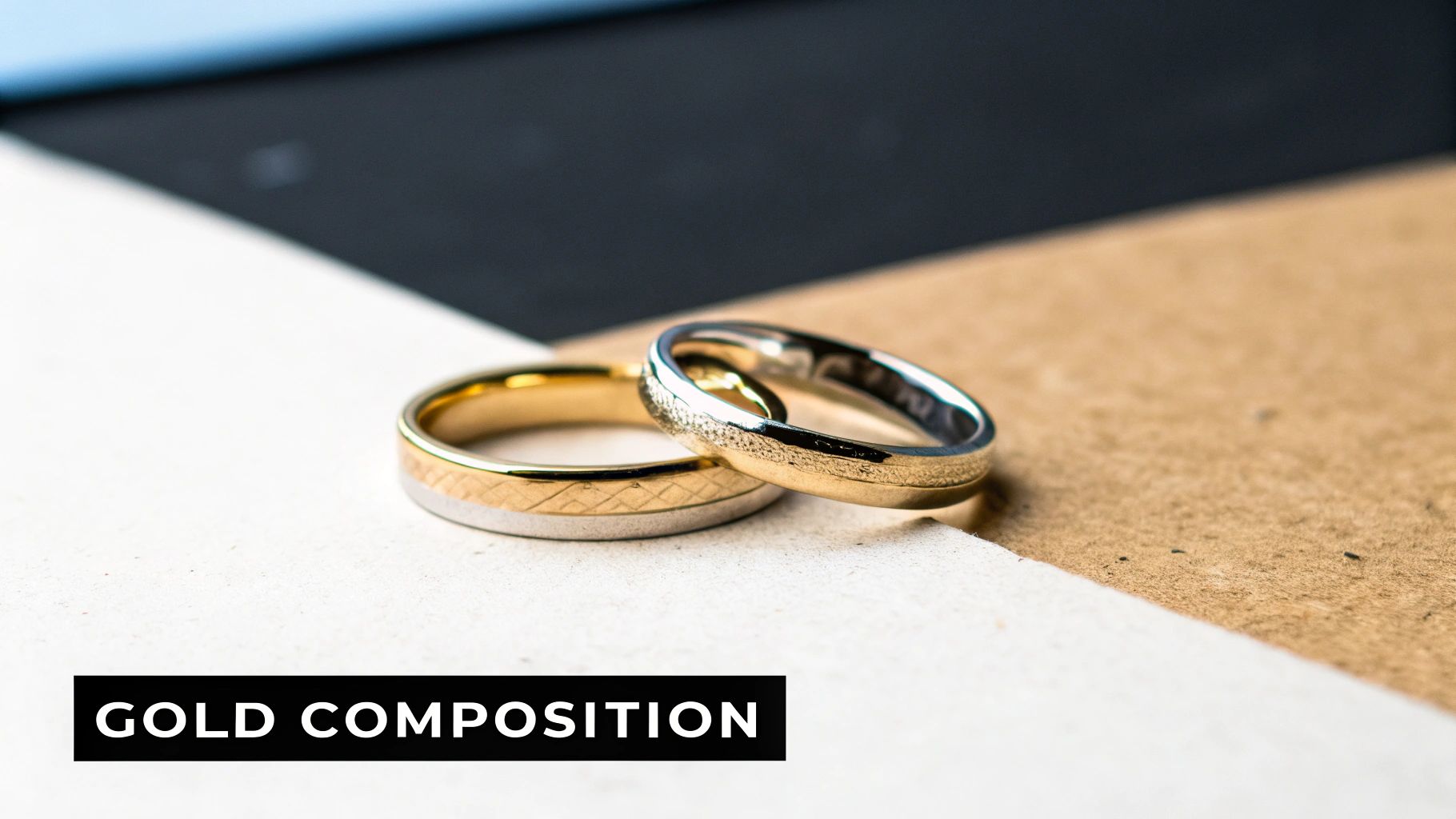
Pure 24k gold is far too soft for jewellery, so it's mixed with other metals (alloys) to make it stronger. It's the type of alloys used in white and yellow gold that gives them their unique durability characteristics.
Scratch Resistance and Hardness
If you compare them karat for karat, white gold generally comes out slightly ahead in hardness. That's because the alloys used to create its white colour, like palladium or nickel, are harder than the copper typically found in yellow gold alloys.
What does this mean for you? A 14k white gold ring might fend off minor scuffs a little better than a 14k yellow gold one. If you have a hands-on job or an active lifestyle, that extra bit of resilience can be a real plus.
But yellow gold has a trick up its sleeve. Because it's a bit softer, when it gets scratched, the metal tends to be pushed aside rather than flaked away. A skilled jeweller can often buff and polish those marks right out, restoring the ring's finish without any significant loss of gold.
The Deciding Factor: Rhodium Plating
Here’s where the maintenance paths for white and yellow gold really diverge. The brilliant, mirror-like shine you associate with white gold isn’t its natural state; it comes from rhodium plating.
As we’ve touched on, white gold's true colour is a slightly creamy, off-white. To get that dazzling, silvery-white finish, jewellers apply an ultra-thin coating of rhodium—a hard, reflective metal from the platinum family.
The rhodium plating on white gold is not a permanent feature. It’s a surface treatment that will wear away over time, and it needs to be professionally reapplied to keep the metal looking its best.
This plating wears down with daily friction and exposure to chemicals (like hand sanitisers or cleaning products). If you wear your engagement ring every day, you'll likely need to have it replated every 12 to 24 months. As the rhodium wears thin, you’ll start to see the warmer, slightly yellowish hue of the gold alloy underneath, especially on the bottom of the band.
Maintenance Routines Compared
Knowing what to expect for upkeep is crucial for making a choice you'll be happy with for years to come. Let's break down the typical maintenance schedules.
White Gold Maintenance:
- Regular Re-plating: This is the big one. To keep your ring looking crisp and white, you'll need to commit to having it professionally cleaned, polished, and electroplated with a fresh layer of rhodium periodically.
- Ongoing Cost: While not a massive expense, the recurring cost of re-plating is something you should factor into your long-term budget.
- The Payoff: The reward for this regular upkeep is a consistently brilliant, icy-white finish that makes colourless diamonds pop.
Yellow Gold Maintenance:
- Beautifully Simple: Yellow gold’s warm colour is solid all the way through, so there’s no plating to worry about. It will never change its hue.
- Occasional Polishing: All it really needs is a professional polish every few years to smooth out any minor surface scratches and bring back that high-shine lustre.
- Lower Long-Term Cost: With no re-plating necessary, yellow gold is generally the more affordable option when it comes to lifetime maintenance.
In the end, it boils down to what you value most. White gold offers a bit more scratch resistance from the get-go but requires a consistent maintenance routine to maintain its iconic colour. Yellow gold is the low-maintenance classic, asking for little more than a simple polish to keep it looking fantastic for generations.
Finding Your Metal: Matching Gold to Skin Tone and Personal Style
Choosing between white gold and yellow gold isn't just a technical decision; it's deeply personal. The right metal should feel like it belongs to you, complementing your skin and reflecting your individual style. Are you drawn to a cool, contemporary aesthetic, or does a timeless, classic warmth speak to you more?
Think of it this way: white gold’s silvery-white lustre is like a brilliant mirror, catching the light and creating a sharp, modern feel. It’s perfect for sleek, minimalist designs. Yellow gold, on the other hand, casts a rich, warm glow, giving jewellery a softer, more traditional character.
What’s the Best Match for Your Skin Tone?
A great way to start is by seeing how each metal looks against your skin’s natural undertones. While your personal taste should always be the final decider, this little trick can point you in the right direction.
White Gold for Cool Skin Tones
The crisp, bright finish of white gold is incredibly flattering on cool skin tones. If you notice pink, red, or blueish undertones and the veins on your wrist appear blue, white gold will almost certainly look fantastic. It creates a beautiful, clean contrast without washing out fairer complexions.
Yellow Gold for Warm Skin Tones
Conversely, yellow gold is absolutely stunning against warm skin tones. If your complexion has golden, peachy, or yellow undertones and your veins look a little more greenish, the radiant glow of yellow gold will bring out the best in your skin. It adds a beautiful warmth to olive, tanned, or darker skin tones.
A Pro Tip: Don't just hold a piece of metal near your hand. The best way to know for sure is to actually try on a ring or a necklace. Seeing how the metal’s colour plays with your specific skin tone in real light makes all the difference.
Aligning Your Choice with Your Personal Style
Beyond your complexion, the metal you choose is a reflection of your personality. Think about your wardrobe, the art you love, and the other jewellery you wear. Does your style lean modern and edgy, or classic and romantic?
If your look is built around clean lines, architectural shapes, and a more neutral palette, white gold’s sleekness will slot in perfectly. It has a sharp, polished feel that complements a minimalist wardrobe beautifully.
On the other hand, if you’re drawn to vintage-inspired fashion, romantic details, and warmer colours, yellow gold is a natural fit. Its timeless appeal has a sense of history and tradition, making it the perfect choice for classic solitaires or pieces with intricate, old-world charm.
The Big Comeback: Yellow Gold's Resurgence in Australia
For years, white gold (and its pricier cousin, platinum) dominated the engagement ring market. But we're seeing a real shift in Australian tastes. The classic warmth of yellow gold is making a major comeback, and not just in wedding jewellery.
The numbers don't lie. Recent industry data shows a massive swing, with yellow gold now featuring in 46% of jewellery pieces, a huge jump from its previous share of 32.2%. This 14-percentage-point increase signals a genuine return to warmer, more traditional aesthetics. If you're interested in the data, you can read more in The Australian Consumer Report 2024 on jewelleryworld.net.au.
At the end of the day, the right choice is simply the one you love. Whether you’re drawn to the modern cool of white gold or the timeless warmth of yellow gold, picking the metal that truly connects with your skin and your style is the key to a piece you'll treasure forever.
When it comes to choosing between white gold and yellow gold, budget is always part of the conversation. It’s a common misconception that one is inherently more expensive than the other, but the real story is a bit more nuanced, especially here in the Australian market.
The value of any gold ring is rooted in its pure gold content. So, an 18k white gold ring and an 18k yellow gold ring of the same size and weight have the exact same amount of pure gold—75%, to be precise. That means their intrinsic value is identical. The price difference you’ll see at the jeweller's counter comes down to the manufacturing process, not the gold itself.
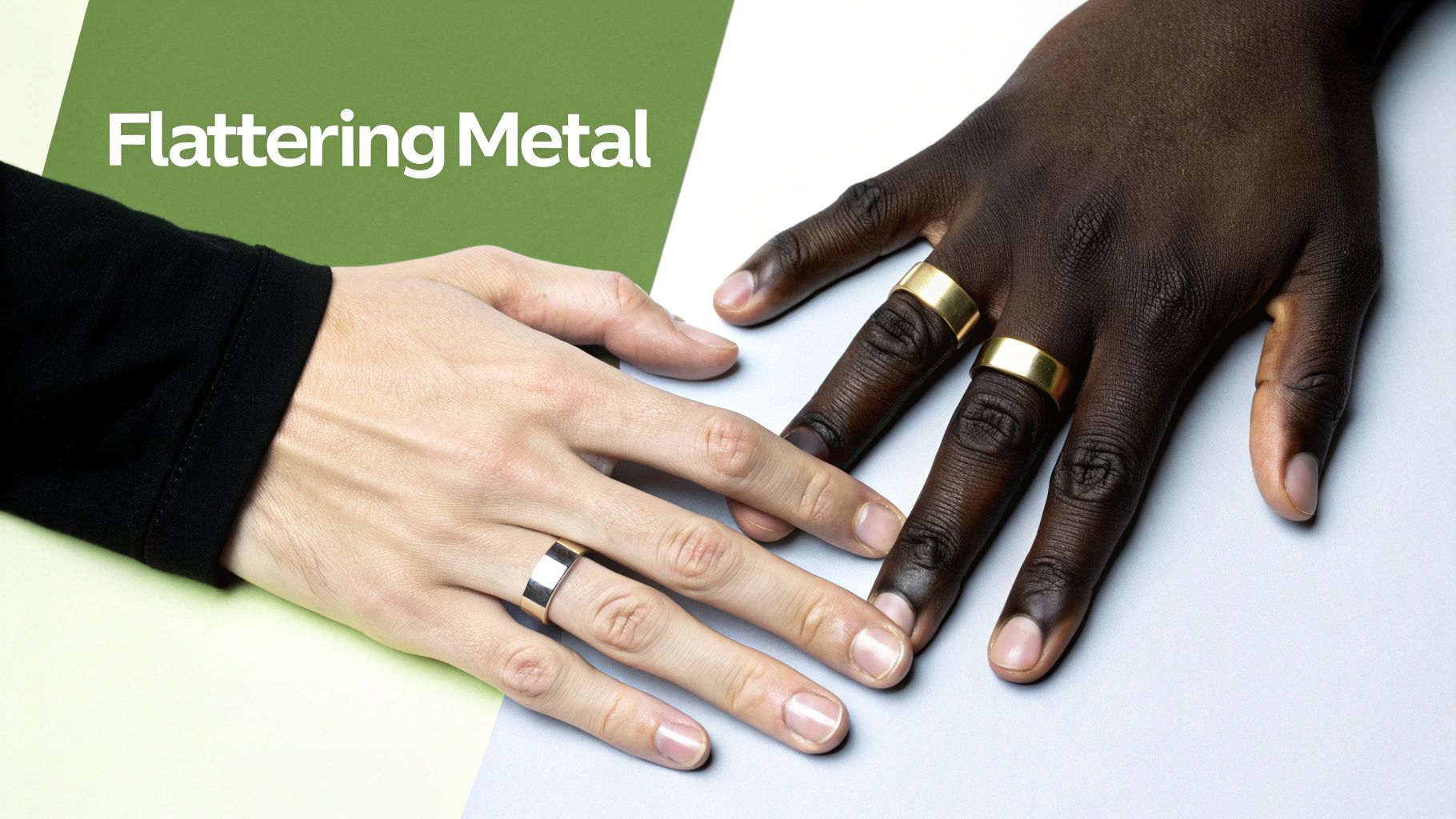
Upfront Investment vs Long-Term Costs
You’ll often notice that white gold pieces have a slightly higher price tag from the get-go. This isn't arbitrary; it boils down to two key steps in its creation.
- Alloy Composition: To get that silvery-white hue, white gold is mixed with more expensive white metals like palladium. Yellow gold, by contrast, uses more common and less costly alloys like copper and zinc.
- Rhodium Plating: Every piece of white gold we create gets a final, crucial finish—a fine layer of rhodium. This gives it that stunning, bright lustre you see. It’s an extra step requiring skilled hands and specialised equipment, which adds a little to the initial cost.
This initial difference is usually pretty small, but the financial story doesn't stop once you walk out the door.
The true cost of owning a ring isn't just the price you pay today. While yellow gold is fairly low-maintenance, white gold needs a bit of ongoing care with re-plating, which is a recurring long-term expense.
Yellow gold is wonderfully straightforward. It might need a professional polish every few years to buff out any scratches and restore its shine. White gold, however, needs its rhodium plating reapplied every 12 to 24 months to keep looking its best. Over the years, the cost of this service can add up.
To put this into perspective, let's look at a hypothetical five-year cost projection for an 18k engagement ring. This helps illustrate how the ongoing maintenance of white gold can influence the total investment over time.
Cost and Maintenance Investment Over 5 Years
| Factor | 18k White Gold (Example) | 18k Yellow Gold (Example) |
|---|---|---|
| Initial Purchase Price | $2,200 | $2,100 |
| Rhodium Plating (every 18 months) | $80 – $120 per session | N/A |
| Number of Re-plates in 5 Years | 3 sessions | 0 sessions |
| Total Maintenance Cost (5 Years) | $240 – $360 | $50 – $80 (for one polish) |
| Total Estimated Investment | $2,440 – $2,560 | $2,150 – $2,180 |
As you can see, while the initial price gap is small, the long-term costs can shift the balance, potentially making yellow gold a more economical choice over the life of the piece.
What Aussies Are Choosing
The Australian jewellery scene provides an interesting backdrop for this decision. The local market is growing steadily—projected to expand from around USD 3.02 billion in 2024 to USD 3.69 billion by 2030. Yet, within this growth, the average spend on an engagement ring has settled just over AUD 4,000, which tells us that shoppers are becoming more price-conscious. This trend might favour yellow gold, which many see as a timeless store of value with lower ongoing costs. You can explore more of these jewellery market forecasts from techsciresearch.com.
Ultimately, while the initial cost difference between white and yellow gold is often minimal, understanding the full financial picture is key. By weighing the upfront price against the long-term maintenance, you can make a choice for your custom Daniel Fine piece that feels right for your style and your budget.
How Gold Colour Affects Gemstone Appearance
The metal you choose for your ring does far more than just secure a gemstone. It’s an active participant in how that stone looks, feels, and tells its story. Whether you opt for the cool, crisp stage of white gold or the rich, warm backdrop of yellow gold, the setting can dramatically change how a diamond or moissanite presents to the eye. It's a fundamental part of designing a piece that feels truly cohesive.
Think of it like framing a piece of art. The right frame makes the colours within the painting pop and brings its details into focus. In exactly the same way, your choice of gold will either amplify a diamond's icy brilliance or complement it with a warm, inviting glow.
White Gold: A Mirror for Brilliance
White gold’s defining feature is its bright, silvery-white surface, which comes from its rhodium plating. This highly reflective finish essentially surrounds the gemstone with tiny mirrors, bouncing light back through the stone and amplifying its natural sparkle. The effect is especially striking with diamonds.
When you set a colourless diamond (think D-G colour grades) in white gold, it looks even brighter and whiter. The neutral setting doesn't cast any colour into the stone, letting the diamond’s natural fire and brilliance completely steal the show.
- Creates an Illusion of Size: The almost seamless transition from the white metal to a colourless stone can trick the eye, making the diamond appear larger than it actually is.
- Maximises Sparkle: Its reflective quality intensifies the light performance, making the diamond look incredibly brilliant.
- Ideal for Colourless Stones: It’s really the perfect match for high-grade diamonds and moissanite where the goal is to preserve that pure, icy-white look.
White gold is the ultimate amplifier for a colourless diamond. Its neutral, reflective surface ensures that nothing distracts from the stone's natural beauty, making it appear as crisp and brilliant as possible.
Yellow Gold: A Backdrop of Warm Contrast
Yellow gold provides a totally different, but just as beautiful, aesthetic. Its classic, warm hue creates a stunning contrast against a bright white gemstone, making the stone stand out with a bold, timeless elegance. This can be a particularly smart choice for diamonds that carry a little warmth.
A yellow gold setting can be incredibly flattering for diamonds in the near-colourless range (typically H-K grades). The warmth of the metal actually helps these diamonds appear whiter by comparison. Your eye is drawn to the stark colour difference between the gold and the stone, rather than noticing any subtle yellow tones within the diamond itself. It’s a clever design choice that delivers a high-impact look.
Ultimately, choosing between white and yellow gold comes down to the aesthetic you're after. Do you want to push a diamond’s icy fire to the max with a sleek, reflective setting? Or would you prefer a timeless piece where the warm glow of classic gold makes your gemstone truly pop? Understanding how these metals play with light and colour is the key to designing a custom Daniel Fine piece that perfectly captures your vision.
Answering Your Top Gold Jewellery Questions
When you’re designing a custom piece of jewellery, it’s only natural to have questions. Beyond the big picture of aesthetics and durability, it’s the smaller, practical details that often make the final decision. To help you feel completely confident, we've put together answers to the most common questions we hear from clients navigating the white gold vs. yellow gold choice.
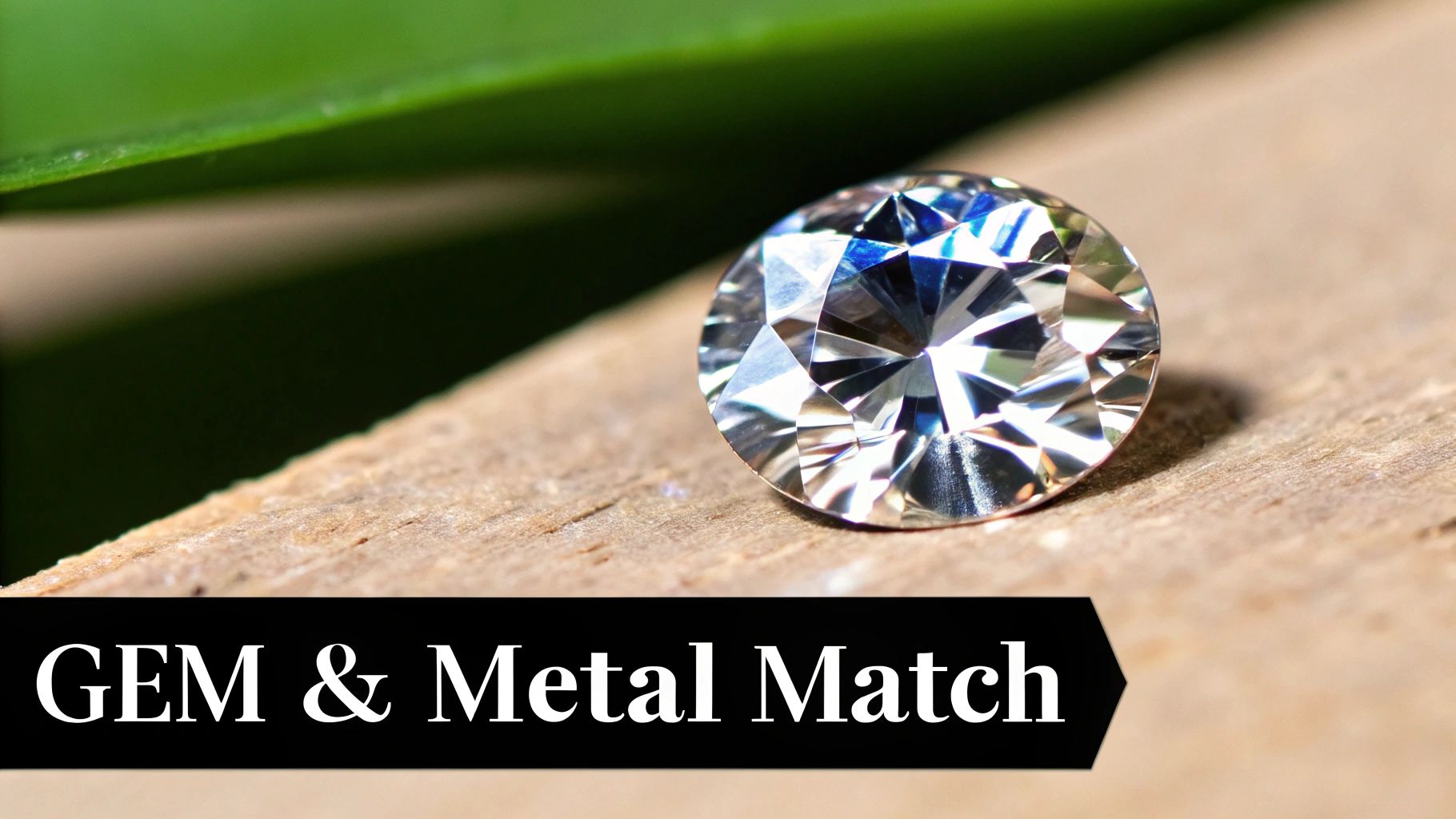
These are the real-world concerns that matter when you’re investing in a piece you’ll wear and love for a lifetime.
Is White Gold Considered Real Gold?
Yes, absolutely. White gold is 100% real gold. It’s a genuine gold alloy, made by blending pure yellow gold with white metals like palladium or silver. This process doesn't just change the colour; it also adds strength and durability.
Think of it this way: an 18k white gold ring has the exact same amount of pure gold as an 18k yellow gold ring—a solid 75%. The only difference is in the other 25% of the metal mix, which is what gives white gold its cool, silvery hue.
Which Gold Is Better for Sensitive Skin?
If you have sensitive skin, yellow gold is generally the safer bet. Its common alloys, usually copper and zinc, are very rarely the cause of skin irritation, making it a naturally hypoallergenic choice.
With white gold, the main thing to watch out for is nickel. It's a common allergen used in some older or mass-produced alloys that can cause a reaction in some people.
But this doesn't mean you have to rule out white gold. High-quality jewellers, including Daniel Fine, use modern alloys that are completely nickel-free. We use palladium, a hypoallergenic metal from the platinum family, to create our white gold. Just make sure to confirm the alloy with your jeweller to guarantee your piece is perfect for everyday wear.
When it comes to sensitive skin, the real issue isn't white gold itself, but the potential for nickel in the alloy. By choosing a palladium-based white gold, you get the beautiful, crisp look you want without any risk of irritation.
Can You Wear White and Yellow Gold Together?
Without a doubt. Mixing metals has moved far beyond a fashion "don't" and is now a sign of sophisticated, personal style. The contrast between the cool brilliance of white gold and the rich warmth of yellow gold creates a really dynamic and eye-catching look.
There are some fantastic ways to make this work:
- Stacking Rings: This is a classic. A white gold engagement ring paired with a yellow gold wedding band, or vice versa, looks incredible.
- Layering Necklaces: Try combining delicate chains in both metals for a modern, textured feel.
- Two-Tone Pieces: You can also work with a jeweller to design a custom piece that intentionally incorporates both metals from the start.
Ultimately, wearing them together is a brilliant way to build a jewellery collection that feels curated, unique, and completely you.
Does White or Yellow Gold Have a Better Resale Value?
The resale value of any piece of gold jewellery comes down to its actual gold content, not its colour. The value is calculated based on two key things: the karat weight and the current market price of gold.
This means an 18k white gold ring and an 18k yellow gold ring of the same weight will have the same intrinsic gold value. While fashion trends might slightly influence demand for one colour over another in the secondhand market, the fundamental value is always tied directly to the precious metal itself.
At Daniel Fine, we believe your jewellery should be a perfect reflection of you. Whether you're drawn to the modern brilliance of white gold or the timeless warmth of yellow gold, our bespoke design process ensures your vision comes to life. Explore our custom engagement rings and fine jewellery to begin creating your story.
Article created using Outrank

